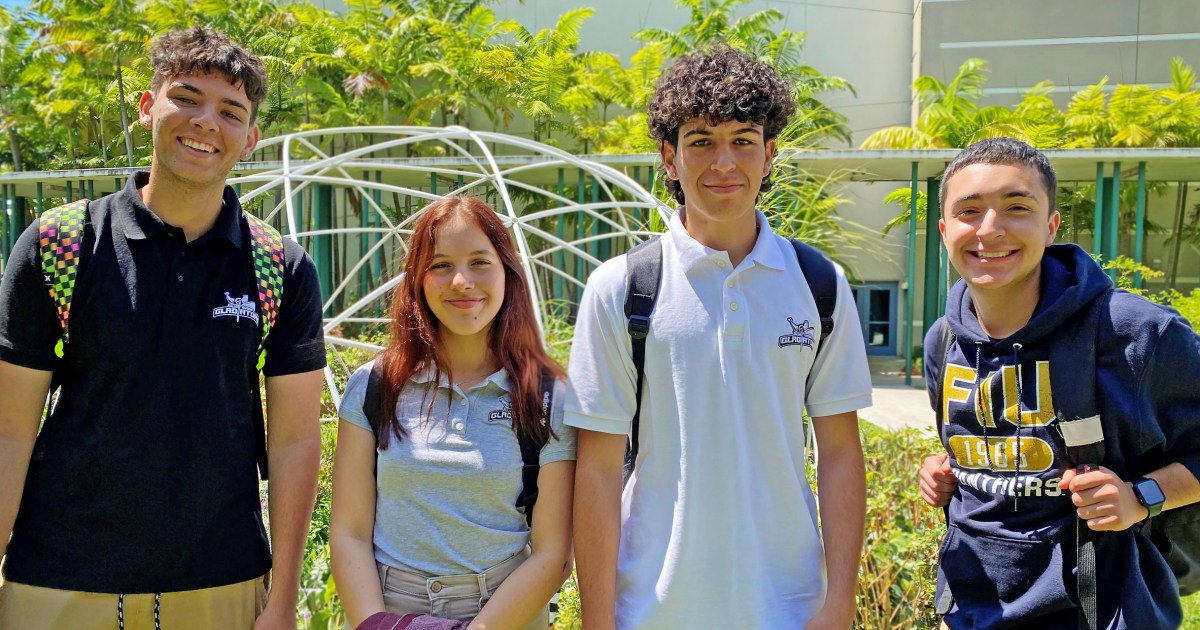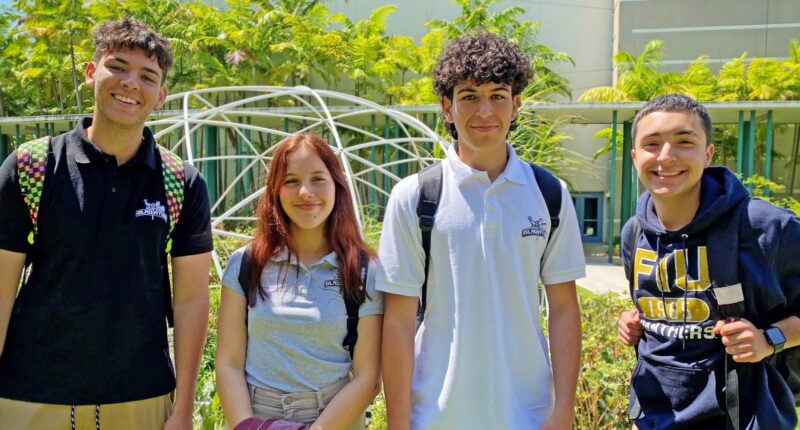
HIALEAH, Fla. — Brothers Jaddiel and Genier Águila, ages 16 and 17, came from Cuba in August, crossing the U.S.-Mexico border with their parents and settling into a new world in the working-class city of Hialeah, in Miami-Dade County.
The brothers say they didn’t like how the education system on the communist-run island they left behind is politicized, and they speak with enthusiasm about the new freedom they have here.
“In Cuba you can’t express yourself,” Genier Águila said.
The brothers are quickly learning English and excelling in the veterinary and engineering programs they are enrolled in at Hialeah Gardens High School, a sprawling campus that enrolls about 3,000 students.
But the school, like the rest of the Miami-Dade County Public Schools system, is grappling with a sharp rise in immigrant enrollment this school year. Since August, about 19,000 students have enrolled in public schools throughout the county, according to the district. Miami-Dade County Public Schools recently surpassed Chicago Public Schools as the third largest in the nation.
Schools are already dealing with a deficit of teachers, and they have reached the financial cap for students of English for Speakers of Other Languages, or ESOL, which is estimated at the beginning of every school year. Because the district hit the cap, it’s creating financial strain, as additional costs are associated with teaching and providing resources to ESOL students.
According to the district, the vast majority of students are from Cuba, with lesser numbers from Nicaragua and Venezuela, where families are fleeing left-wing authoritarian governments.
As of February, over 9,500 Cuban students had enrolled in public schools this year, compared to 2,977 in all of 2021-22. Also as of February, 1,400 Nicaraguan and 1,100 Venezuelan students had also enrolled in the district.
Some students are still enrolling even though the school year ends next month, district officials said.
The schools with the highest enrollments are in the suburbs of Hialeah, known for its heavy Cuban community, and Doral, with a large concentration of Venezuelans.
Superintendent José Dotres and school board members have traveled to the state capital, Tallahassee, and Washington, D.C., to lobby for additional assistance.
“Let me be clear: It’s all over the county,” said Luisa Santos, a school board member. “There are very few schools that have not received enrollments from students out of the country.”
Santos, who attended public schools in Miami, came from Colombia when she was 8 years old and discovered she was undocumented when she was a junior in high school.
“This is very personal to me — our schools welcomed me, they invested in me, they made sure I learned English. I was put in a gifted program, I was put in a magnet program, and they gave me the education that now allows me to serve all these students,” she said.
Hialeah Gardens High School began the school year with 160 students in the ESOL program and now has over 322, said Vivian López, the head of the department. Every week she gets six to 10 new students, even though the academic year is ending soon.
“The population has grown a lot and very rapidly,” López said. “Honestly, we weren’t prepared.”
In classes that should have a maximum of 24 students, there are now 45. There aren’t enough chairs, so kids have to sit on the floor.
“You can’t even walk inside the classroom,” said López, who has resorted to using a microphone so students can hear her and a whistle when she needs to call for their attention.
“It’s tough, because they all have concerns, but you can’t help them all at the same time. Either you address their individual needs or you teach the class,” she said.
There isn’t just a shortage of teachers. The schools also need more psychologists, but there is a shortage of mental health professionals in Miami. Many of the students coming in have been through dramatic situations during their treks through Central America.
“When we have a child that is struggling emotionally or in terms of education, we have to make sure that we run a whole bunch of tests, including an IQ test, psychological exams, and that’s done by a school psychologist,” said María Muñoz, one of the high school’s counselors. “We’re sharing one with five or six schools, and that’s awful, because these kids need to be seen right away.”
The population of immigrant students at the high school has grown so much that a senior, Daniel Mejía, launched an organization called the English Language Learner Club to help students adjust peer-to-peer. Mejía knows well the challenges new students face; he experienced them when he came from Colombia in 2019. He quickly learned English and will attend Florida International University after he graduates this year.
“The idea is to help with the process, help them adapt, and for them to understand how the grades work, the periods, AP classes, how the school’s academies function and so on,” Mejía said. “We also explain to them the opportunities they have after high school, like scholarships.”
Worsening the situation is a decline in funding from the state over the past several years. In the 2004-05 school year, 61% of funding came from the state and 39% from the county, according to data shared by the school district. But by the 2022-23 school year, only 42% of funding was coming from the state, requiring the county to come up with the other 58%.
Miami-Dade County and other large counties in the state are donor counties for smaller counties that don’t create enough revenue to fund schools and other services. But teachers need higher salaries in the Miami area, where the cost of living is significantly higher than in smaller towns.
As a result, the county has resorted to voter referendums, like one passed in November, to help increase teacher pay and fund school security measures.
The number of immigrant students is expected to continue rising. As record numbers of migrants tried to cross the U.S.-Mexico border, including over 220,000 Cubans in one year, the Biden administration implemented a parole program for applicants from Cuba, Venezuela, Nicaragua and Haiti. Up to 30,000 people from the four countries are eligible for humanitarian parole every month, which enables them to work in the U.S. for two years.
Some families have made the dangerous trek through Central America to get to the U.S.
Nivis Fernández, 17, came from Cuba with her parents in October. They flew to Nicaragua and spent 26 days traveling through Honduras, Guatemala and Mexico. The family were kidnapped in Mexico and held for $6,000, which relatives in the U.S. paid.
Now at Hialeah Gardens High School, Fernández is enrolled in the academy of fashion and tourism. She plans to go to college after she graduates to study psychology.
“In Cuba, you can’t share your way of thinking,” Fernández said as she and other students discussed what it was like to go to school in their home country. “We barely had supplies like pencils and notebooks. If you have relatives here, they would have to send them.”
Source: | This article originally belongs to Nbcnews.com









